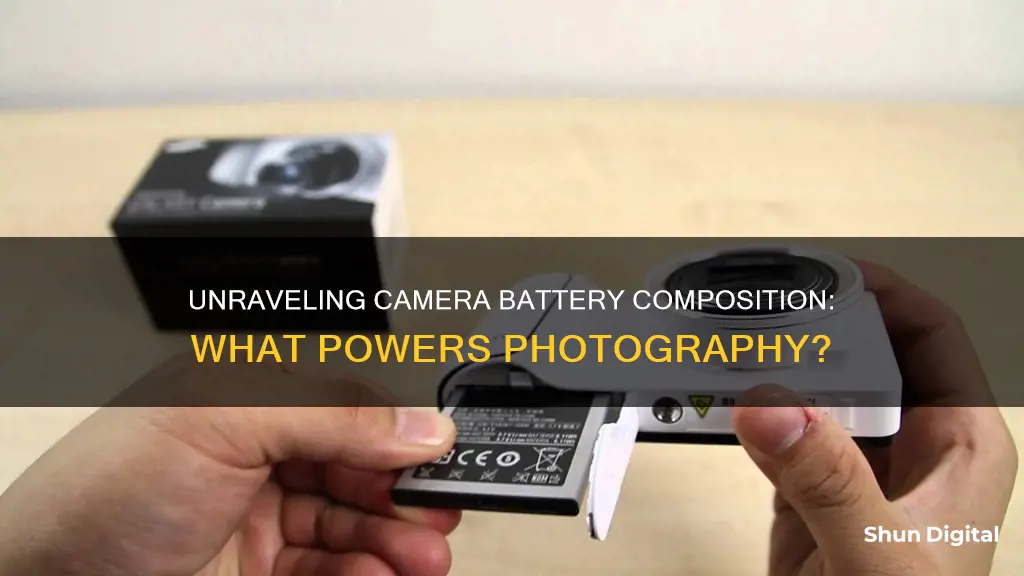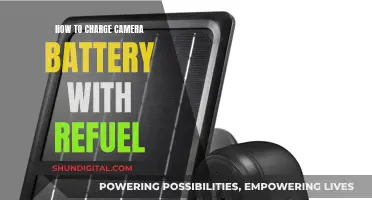
Camera batteries have come a long way since the small button batteries used in older 35mm film cameras, which could last for several weeks or even months. Today, most camera batteries are lithium-ion (Li-ion) cells, which are lightweight, rechargeable, and deliver higher voltage than other cell types. Inside a Li-ion battery are electrodes made of lightweight lithium and carbon, with the highly reactive lithium storing a lot of energy in its atomic bonds. This gives Li-ion batteries a high energy density, allowing them to store more electricity per kilogram than other batteries.
While Li-ion batteries are popular, they do have some drawbacks. They start degrading as soon as they leave the factory and are sensitive to high temperatures, which can cause them to degrade faster. Additionally, completely discharging a Li-ion battery will ruin it. Despite these disadvantages, Li-ion batteries remain the standard for camera equipment due to their high energy density and rechargeable nature.
| Characteristics | Values |
|---|---|
| Composition | Lithium cobalt oxide, carbon, metal, organic solvent, plastic |
| Shape | Cylindrical or prismatic |
| Voltage | 3.7 volts per cell |
| Energy Density | 150 watt-hours of electricity in 1 kilogram of battery |
| Charge Retention | Loses about 5% of its charge per month |
| Memory Effect | None |
| Charge/Discharge Cycles | Hundreds |
| Lifespan | 2-3 years |
| Temperature Sensitivity | Sensitive to high temperatures |
| Full Discharge | Ruins the battery |
| On-Board Computer | Required |
| Failure Mode | May burst into flame |
What You'll Learn
- Lithium-ion batteries are rechargeable and lightweight
- They are sensitive to high temperatures and can be ruined if completely discharged
- They have no memory effect, so you don't need to fully discharge them before recharging
- They can be cylindrical or prismatic in shape
- They are popular in laptops, cell phones, and cameras

Lithium-ion batteries are rechargeable and lightweight
Lithium-ion batteries are generally much lighter than other types of rechargeable batteries of the same size. The electrodes of a lithium-ion battery are made of lightweight lithium and carbon. Lithium is a highly reactive element, meaning a lot of energy can be stored in its atomic bonds, resulting in a very high energy density.
For example, a typical lithium-ion battery can store 150 watt-hours of electricity in 1 kilogram of battery. In comparison, a NiMH (nickel-metal hydride) battery pack can store about 100 watt-hours per kilogram, while a lead-acid battery can only store 25 watt-hours per kilogram. This makes lithium-ion batteries ideal for small devices like cell phones and cameras.
In addition to their lightweight and high energy density, lithium-ion batteries offer several other benefits. They hold their charge, losing only about 5% of their charge per month compared to a 20% loss for NiMH batteries. They also have no memory effect, which means you don't need to completely discharge them before recharging. Lithium-ion batteries can typically handle hundreds of charge/discharge cycles and last two to three years from the date of manufacture.
However, it's important to note that lithium-ion batteries do have some disadvantages. They are extremely sensitive to high temperatures and will degrade faster when exposed to heat. Completely discharging a lithium-ion battery will ruin it. Additionally, there is a small chance that a lithium-ion battery could burst into flame if it fails.
Despite these drawbacks, lithium-ion batteries remain a popular choice for camera equipment due to their high energy density, lightweight construction, and rechargeable nature.
The Ultimate Battery Backup Plan for Photographers
You may want to see also

They are sensitive to high temperatures and can be ruined if completely discharged
Camera batteries are sensitive to high temperatures and can be ruined if completely discharged. Lithium-ion (Li-ion) batteries are the most common type of camera battery. They are lightweight, rechargeable, and capable of delivering a higher voltage than other cell types. However, they are sensitive to high temperatures and can be damaged if exposed to excessive heat.
Li-ion batteries should be stored at a reasonable temperature to prevent self-discharging. Ideally, they should be stored in a cool, dry place with an ambient temperature of 15°C to 25°C (59°F to 77°F). Higher temperatures can cause the battery to deteriorate and lose performance. Similarly, charging the battery at high temperatures can impair its performance and may even cause it to explode. Therefore, it is important to allow the battery to cool down before charging it.
In addition to temperature sensitivity, Li-ion batteries should not be completely discharged. Repeatedly turning the camera on or off when the battery is fully discharged will shorten its life. Instead, it is recommended to store Li-ion batteries with a partial charge. If the battery is not going to be used for a while, it is best to insert it into the camera and run it flat before removing it for storage.
Overall, proper care and storage of camera batteries, especially Li-ion batteries, are crucial to maintaining their performance and longevity. By storing them at the right temperature and avoiding complete discharge, photographers can ensure that their camera batteries remain functional and reliable for an extended period.
Charging Your SeaLife Camera: A Step-by-Step Guide
You may want to see also

They have no memory effect, so you don't need to fully discharge them before recharging
Camera batteries have come a long way since the days of the 35mm film camera, where batteries could last for weeks or even months. Nowadays, digital cameras are far more power-hungry, and photographers need to be mindful of their battery life and how to get the most out of their equipment.
When it comes to rechargeable batteries, one common concern is the "memory effect". This phenomenon is observed in nickel-cadmium and nickel-metal hybrid batteries, where the battery appears to "'remember' shorter life cycles if it is repeatedly charged before its energy is fully expended. Fortunately, this effect is almost non-existent in Lithium-ion (Li-ion) batteries, which are the most common type of camera battery. Li-ion batteries can be recharged many times and do not need to be fully discharged before recharging, thanks to their lack of a memory effect.
The memory effect can result in a reduction in the usable capacity of a battery and can lead to a wrong estimation of the State of Charge (SoC). This means that the application using the battery may show a different estimation of the energy left compared to the real energy it can deliver. However, this is not a concern with most Li-ion cells, except for lower-grade Lithium Iron Phosphate (LFP) cells or those stored in harsh conditions for extended periods.
Li-ion batteries offer several advantages for photographers. They are extremely lightweight and capable of delivering a higher voltage than other cell types. They also have a lower tendency to self-discharge when not in use, making them ideal for photographers who need to keep their equipment ready for action at a moment's notice.
In summary, the absence of a memory effect in most Li-ion camera batteries means that photographers can recharge their batteries whenever convenient, without worrying about fully discharging them first. This flexibility, combined with the lightweight and high-performance characteristics of Li-ion batteries, makes them a popular choice for photographers who demand reliable and long-lasting power for their digital cameras.
Reviving Dead Camera Batteries: Simple Hacks to Try
You may want to see also

They can be cylindrical or prismatic in shape
Camera batteries can come in a variety of shapes and sizes, depending on the make and model of the camera. One of the most common types of camera battery is the lithium-ion battery, which is often found in laptops, cell phones, and iPods. These batteries are popular due to their high energy density, lightweight construction, and lack of a memory effect.
Lithium-ion battery packs for cameras typically consist of either cylindrical or prismatic cells. The prismatic cells are square or rectangular in shape, while the cylindrical batteries resemble AA cells in appearance. Despite their differing forms, both types of cells are constructed using similar components and function in the same way.
Inside a lithium-ion battery cell, you will find a positive electrode made of lithium cobalt oxide (LiCoO2) and a negative electrode made of carbon. These electrodes are submerged in an organic solvent, typically ether, which acts as the electrolyte. A very thin sheet of microperforated plastic, known as the separator, is used to separate the positive and negative electrodes while allowing ions to pass through.
When the battery charges, lithium ions move through the electrolyte from the positive electrode to the negative electrode and attach to the carbon. During discharge, the lithium ions move back to the LiCoO2 from the carbon, generating an electric current. This movement of ions occurs at a relatively high voltage, resulting in a cell voltage of 3.7 volts, which is significantly higher than the 1.5 volts of a standard AA alkaline cell.
The high voltage and energy density of lithium-ion batteries make them well-suited for small devices like cell phones and cameras, where space is limited. Additionally, their lightweight construction and lack of a memory effect make them a convenient and popular choice for photographers and other electronic device users.
Attaching Camera Battery Pack: A Step-by-Step Guide
You may want to see also

They are popular in laptops, cell phones, and cameras
Lithium-ion batteries are extremely popular in laptops, cell phones, and cameras. They are so common because, pound for pound, they are some of the most energetic rechargeable batteries available. They are also lightweight, with their electrodes made of lightweight lithium and carbon. Lithium is a highly reactive element, meaning a lot of energy can be stored in its atomic bonds, resulting in a very high energy density.
Lithium-ion batteries have a number of advantages over competing battery technologies:
- They hold their charge. A lithium-ion battery pack loses only about 5% of its charge per month, compared to a 20% loss per month for NiMH batteries.
- They have no memory effect, meaning they do not have to be completely discharged before recharging.
- They can handle hundreds of charge/discharge cycles.
However, they do have some disadvantages:
- They start degrading as soon as they leave the factory and will only last two to three years, whether used or not.
- They are extremely sensitive to high temperatures, which causes faster degradation.
- If you completely discharge a lithium-ion battery, it is ruined.
- They are expensive, as they require an onboard computer to manage the battery.
- There is a small chance that if a lithium-ion battery fails, it will burst into flame.
Lithium-ion batteries are so popular in laptops, cell phones, and cameras because they are lightweight, hold their charge well, and can be recharged hundreds of times. However, their sensitivity to heat and potential to burst into flames are important considerations when using this type of battery.
Charging Pentax Cameras: A Quick Guide to Powering Your Device
You may want to see also
Frequently asked questions
Camera batteries are made of lithium-ion, nickel-metal hydride, or alkaline, among other materials.
To make your camera battery last longer, you can:
- Avoid exposing it to extreme temperatures.
- Avoid deep discharging.
- Store it in a cool, dry place.
- Avoid long time lapses.
- Use a battery grip.
Camera batteries are generally safe, but there is a small chance that they could burst into flames if they fail. They may also leak or explode if handled improperly.







